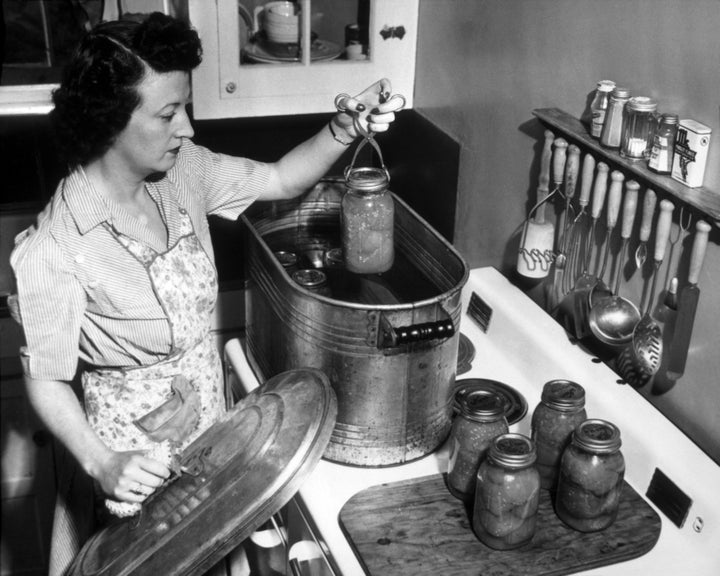During a recent national broadcast about rising food costs and inflation, I was struck by the graphic: An empty shopping cart in front of a refrigerated display of expensive imported cheeses. I don’t think whether or not we can afford a regular supply of brie is what we’re really worried about right now.
Instead, I’d wager that most of us have noticed how our bills have tripled in the past months just from buying staples such as produce, eggs, poultry and meat. And we’re all searching for ways to get that final bill down to a reasonable number at the register.
The best way to do that, I’ve found, is to take lessons from the past. I grew up during the rampant inflation of the ’70s and well remember the ways with which my mother coped. I also gleaned plenty of tips from immigrant grandparents, both my own and those of my classmates, who experienced the Great Depression and World War II rationing. Their recipes and techniques not only still inform how we eat today, they’re helpful for guiding us into thriftier habits.
Many of the guiding principles that helped those generations survive can be used today. Here are some of the best ones.
Use cheaper cuts of meat
For example, your favorite smoked brisket has its roots in the poverty-ridden shtetls of Eastern Europe. Because it was a large, tough piece of meat that took a long time to cook, it was difficult to sell and therefore the cheapest. Jewish immigrants brought it to America, where they settled everywhere from Manhattan to Memphis to Dallas. Brisket kept its roots as a Jewish holiday meal but also became pastrami (in Romania, where it was developed, pastrami was made with goose) and eventually found its way to barbecue joints.
Check out tips 5 and 6 here for some great cheap cuts to try.
Smith Collection/Gado via Getty Images
Stretch your proteins
We’re so used to adding rice to the filling of stuffed cabbage and breadcrumbs to meatloaf that we hardly ever stop to think why. But there are three reasons such recipes developed. For one thing, they used up small bits of leftovers: that last scoop of rice, that heel of bread. For another, they stretched out the amount of meat, making more of it. And finally, by adding such items, they bound the ground protein, preventing it from slipping into sauce.
You can extend your ground proteins with everything from inexpensive root vegetables to crushed crackers that are going stale to the last handful of potato chips lingering in the bag.
Replace expensive ingredients
When times are tough, certain items not only become inexplicably expensive but hard to find. We saw this in May 2021 with the chicken wing shortage, when wings were at an all-time high of $3.25 per pound. Yet thighs were still inexpensive, which baffled people because every chicken has two of each, right? It’s just that thighs simply aren’t as popular.
Now poultry prices in general have tumbled but meat prices are up and expected to remain high until 2025 because of drought issues. Take a note from vegans as well as Latin American cooks everywhere: Beans are nutritious, a heck of a lot cheaper and incredibly filling.

Universal History Archive via Getty Images
Shell egg prices were also high, then fell, and are now creeping back up. Depending on your budget, you may not have any in the house at times. And yet, you can still make Wacky Cake ― developed during the Great Depression/World War II era, it’s one of the most famous examples of how to bake without eggs, milk or butter, relying on vinegar to leaven it.
Repurpose your leftovers
Give your leftovers a new life by incorporating them into new recipes. Save the last few tablespoons of mashed potatoes, the remaining florets of roasted cauliflower, the half of a hamburger, even the remains of a fish fillet. There’s always a way to combine a starchy vegetable and a protein into either hash or a patty. Just add some sautéed or minced onion for flavor.
You can do the same thing with leftover rice and turn it into arancini (rice balls), fried rice or a rice salad.
Pickle and preserve
Pickling and preserving are excellent ways to save produce from rotting. You don’t have to be an expert canner, either, or have a huge batch of anything. Also known as refrigerator pickles, quick pickles don’t require vacuum sealing, and are efficient for a mixed batch of veggies. All you need is a bath of equal parts vinegar and water with salt and sugar (adjust for taste). Add any spices, a clove or two of garlic or herbs to vary the flavor.

Universal History Archive via Getty Images
Use and reuse
Don’t feel like making your own brine? Reuse any pickling brine after you finish a jar of pickles to make more. There’s no reason to throw away a perfectly good brine when you can slice some carrots or red onions into it and preserve them. You can also use pickle brine to marinate your chicken before you fry it.
Ditto the olive oil that comes from jars of artichokes or olives. These make great marinades as well as salad dressings.
Make flavored ice cubes
Freezing is another way to preserve these oils along with fading produce, especially fragile young greens like arugula or herbs. Grind them up with nuts that are in danger of becoming rancid and/or cheese that has been sitting in the fridge too long and pour the mixture into ice cube trays. Voila ― you have pesto cubes. Then you can drop these flavor bombs into soups, turn them into salad dressings, use them to top pastas, or add them to any other dish that needs a dose of flavor.
Save seeds and plant a garden
During World War II, when food rationing and labor shortages had a major effect on supply chains, the government urged private citizens to plant victory gardens to supplement their meals (and show their patriotism). The pandemic made gardening popular again, which also helped relieve stress and anxiety.

Universal History Archive via Getty Images
But you don’t have to go to great lengths to reap the benefits. Every vegetable and fruit ― peppers, tomatoes, cucumbers, melons, avocados ― that you purchase has a pit or seeds that you can then plant. If your onions or garlic sprout before you can eat them, don’t throw them out. Plant them. If your potatoes grow eyes, ditto. And never buy cut fruit, especially pineapple, when you can buy it whole for a lot less money and get the top to boot. A pineapple takes at least a year to grow from its top into a plant that produces another fruit. But if you start every one that you eat, you can have the identical amount by the same time the following year.
Clip coupons and find reward programs
Riffling through an envelope of coupons that we clipped from magazines and newspapers and collecting S&H Green Stamps is certainly a thing of the past. But many stores now offer coupons and rewards digitally. And there are always BOGO deals. If you don’t have enough storage, find a neighbor to split shopping or cooking costs with or form a warehouse club to offset the spoilage from bulk buying. And sign up for rewards programs either at your local stores or through your credit cards. You’d be surprised how much money gets returned to you annually this way.





